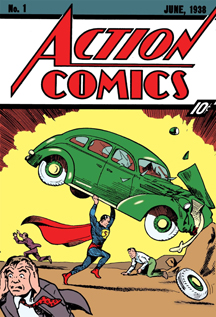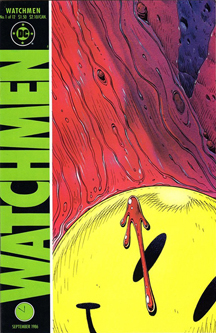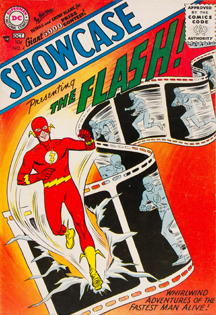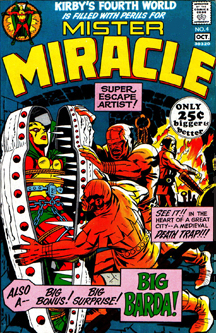
Comic Books Have Been Categorized Into Four Eras Based On When They Were Published. Each Era Has A Different Feel And Tone.

Golden Age 1938 – 1956
1933 | Eastern Color Printing
1935 | National Allied *
1936 | Comics Magazine Co
1936 | Standard Comics
1937 | Ace Comics
1937 | David McKay Pub
1937 | Quality Comics
1938 | All-American *
1938 | Centaur Publications
1938 | Fiction House
1939 | Fawcett Comics
1939 | Fox Feature Syndicate
1939 | Frank Z. Temerson
1939 | Lev Gleason
1939 | MLJ
1940 | Ace Comics
1940 | Columbia Comics
1940 | Crestwood Publications
1940 | Novelty Press
1940 | Street & Smith Comics
1941 | Avon Publishing
1941 | Gilberton Company
1941 | Harvey Comics
1941 | Holyoke Publishing
1943 | ACG
1943 | Dargaud
1943 | Dell Comics
1943 | Magazine Enterprises
1944 | Aviation Press
1944 | EC Comics
1944 | Spark Publications
1945 | Cambridge House
1945 | Charlton Comics
1945 | Green Publishing
1945 | Novack Publishing
1945 | Orbit Publications
1946 | Archie Comics
1946 | National Periodical *
1947 | St. John Publications
1948 | Hillman Periodicals
1949 | Star Publications
1949 | Toby Press
1949 | Youthful
1950 | Ziff-Davis/Approved
1951 | Key Publications
1951 | Master Comics
1951 | Timely-Atlas •
1952 | Comic Media
1952 | Farrell Publications
1953 | Mainline Publications

Modern Age 1985 – Present Day
1986 | Apple Comics
1986 | Dark Horse
1986 | Gladstone Publishing
1986 | Jademan
1986 | Malibu Comics
1986 | Slave Labor Graphics
1986 | Viz Media
1988 | Innovation Publishing
1989 | Caliber Comics
1989 | Valiant Comics
1990 | Disney Comics
1990 | Tundra Publishing
1991 | Drawn And Quarterly
1992 | Image Comics
1992 | Topps Comics
1993 | Bongo Comics
1993 | Defiant Comics
1995 | Tekno Comix
1996 | Radio Comix
1997 | Oni Press
1997 | Top Shelf Productions
1998 | CrossGen
1999 | IDW Publishing
2001 | Insight Studios
2002 | Archaia Entertainment
2004 | Dynamite Ent.
2005 | Boom! Studios
2005 | Cinebook
2005 | Papercutz
2006 | First Second Books
2007 | Library Of American
2015 | AfterShock Comics

Silver Age 1956 – 1970
1957 | Warren Publishing
1958 | I. W. Publications
1961 | Marvel Comics •
1962 | Gold Key
1965 | Tower Comics
1966 | Eerie Publications
1966 | Fitzgerald Publishing
1966 | King Comics
1966 | M. F. Enterprises
1969 | AC Comics

Bronze Age 1970 – 1985
1970 | Skywald Publications
1974 | Atlas-Seaboard
1974 | Humanoïdes
1976 | Fantagraphics
1977 | Aardvark-Vanaheim
1977 | DC Comics *
1977 | WaRP Graphics
1978 | Eclipse Comics
1978 | FantaCo Enterprises
1981 | Capital Comics
1981 | Pacific Comics
1981 | Titan Publishing
1982 | Comico
1982 | Epic Comics
1982 | Vortex Comics
1983 | 1First Comics
1983 | Eagle Comics
1983 | Mirage Studios
1984 | Antarctic Press
1984 | Continuity Comics
1984 | NBM Publishing
1985 | Aircel Comics
1985 | Dragon Lady Press
1985 | Now Comics
Outside The Mainstream

Underground Comix
1965 | Print Mint
1968 | Apex Novelties
1969 | Rip Off Press
1970 | Kitchen Sink Press
1970 | Last Gasp


Scott Conner’s Thoughts On The Four Ages…
Here is why all the terminology for the various ages of comics is so confusing… No one can really agree upon when the Platinum Age started. Some say it was in 1735 when the element was first identified by Antonio de Ulloa, while others say it started in 1931 when women started dying their hair that color after seeing the Howard Hughes movie with the titular hair color. This is also often confused with the Plantium Age, which started in 1982 when Robert Plant’s first solo album was released. Prior to that when he was in Zeppelin, the years 1968-1980 were known as the Led Age.Golden Age is also a very nebulous term. Some people believe it started in 1985 with the first TV broadcast of the show Golden Girls. Others believe the term came into use when the very first bowl of Golden Grahams cereal was eaten in 1978. Even more confusing is that Golden Girls is an episodic TV series but not considered to be a cereal series. More astute fans often place it as beginning in 1977 with artist Michael Golden’s first published work in comics. Finding those early works by him is very difficult and digging them out of back issue boxes often requires the heightened senses of a Golden retriever.The Bronze Age started in 1933 with the publication of the first Doc Savage book. This is often confused with the Copper Age, but that was due to Doc’s actual skin color. And to further complicate things, Copper was first used in the year 1704 to refer to police officers, although dirty coppers was also used to refer to the godawful printing plates used to publish comics which resulted in such poor print quality.The Silver Age also has very little consensus as to when it actually started. Some say it was in 1968 when the first issue of Silver Surfer was published. Others date it as far back as 1911 and the birth of the comedian Phil Silvers. People have been saving up their money to buy Silver Age books since 1836 when the first silver coin was minted in the United States. This is not to be confused with Mint graded Silver Age books. This is also not to be confused with the ever-dwindling average page count of modern comics, which is known as the Silver Age.The Iron Age is universally agreed upon to have started in 1980 with the release of the first Iron Maiden album. The start of the Iron Age is also when people started pressing dilapidated comics with bent spines. This practice became far more common starting in 1988 when the first Star Trek: The Next Generation comic was published, and such pressed comics were known as Bent Spiners. This trend has been verified by multiple Data collectors.The Chrome Age (not to be confused with the first publication of Conan the Barbarian, which is actually the Crom Age) is also sometimes considered to be linked to the first appearance of the Silver Surfer, not only to his skin color but also to his lack of hair which is known as a chrome dome. There was a very poor attempt at giving him a partial hairdo in one issue, but this was quickly abandoned when the artist simply didn’t draw him with enough hair to have anything more than a chromeover. This can also be confused with the character ROM, who had a very similar coloration. This can be further confused by Marvel missing a Golden opportunity to reprint those issues digitally on a CD-ROM. The lack of which results in dubious disc-burned bootleg copies which often pop up on eBay and are referred to as seedy ROMs.
